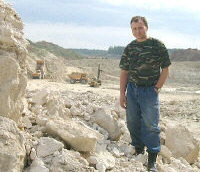Gzhel quarry, Gzhel village
The base of the Gzhelian stage
is marked by an exposure surface in
the Gzhel quarry outcrops. At the end of Kasimovian time, sea level
fell and the marine sediments were exposed to the atmosphere. During
the time of exposure, sediments were exposed to erosion and alteration
as plants grew on them and the top sediments were weathered and
formed a thin soil. With a subsequent rise in sea level and a marine
transgression, waves and currents moved and re-distributed some of
the soil. The base of the Gzhelian preserves some of the weathered
rubble, soil zone, and winnowed sediment redistributed by currents.
The exposure zone is thin and varies greatly within short distances,
consisting of rubble in some places, a thin paleosol (fossil soil) in
others and of reworked sediment in other places.

Contact of base of Gzhelian strata (brown) on top
of Kasimovian
strata (white), corresponding to base of transgressive unit deposited
on exposure horizon on top of Kasimovian limestones.

Basal layer of transgressive unit, consisting of thin
sand bed and
overlying muddy sands with low angle cross-bedding, deposited
on top of white limestone.

Basal layer of transgressive unit, consisting of rubble zone with
blocks of limestone mixed with mud and sand, overlying fragmented
weathered limestone bed. Rubble zone is overlain by resistant dirty
carbonate rock with solution vugs.

Basal layer of transgressive unit, consisting of 10 cm interval of
mud and sand with a high carbonate content, overlying white
Kasimovian limestone. Contact is marked by a very thin (<1 cm) clay
layer. Transition interval is overlain by resistant dirty carbonate
rock with solution vugs.

Basal layer of transgressive unit, consisting of irregularly bedded
calcareous mud and sand with solution vugs produced by dissolution
of large shells. This unit overlies white Kasimovian limestone with an
irregular contact on top of fragmented weathered limestone.

Sharp boundary at contact of Gzhelian and Kasimovian
strata,
containing a very thin clay layer at the exposure surface on top
of white Kasimovian limestone.

Molds of large gastropods (Bellerophon, Omphalotrochus) in dirty
carbonate rock from above exposure surface in section. Note presence
of secondary calcite crystals in some cavities.

